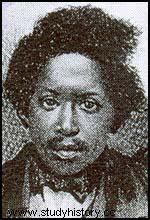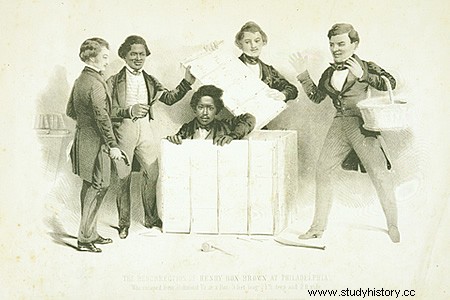In 1830, when he was 15 years old, the slave Henry Brown he was sent to Richmond (Virginia) to work on a tobacco plantation. His life was uneventful until he met Nancy , a slave from an adjacent plantation. After a brief courtship, and with the permission of their respective masters, they obtained permission to marry. Within his limited possibilities were years of happiness with his three children. In 1848, when Nancy was pregnant with her fourth child, Henry received news that his wife and his three children had been sold to a slave trader; he ran off to beg his master not to do it... Helpless, he could only watch as 350 chained slaves -among whom were Nancy and her children- left for North Carolina.

Henry Brown
After several months mourning the loss of his family, he decided that he would get his freedom no matter what it cost... he had nothing to lose anymore. He came up with a brilliant plan:he would mail himself in a box to Philadelphia . He needed the help of two more accomplices, one in Richmond to send the package and one in Philadelphia to receive it. So, through James Caesar Anthony , a former slave who had achieved freedom, he contacted Samuel Alexander Smith , a supporter of the abolitionist cause in Richmond. Henry paid Samuel $86 to handle all the preparations and tasked him with contacting the Philadelphia Anti-Slavery Society (Philadelphia Anti-Slavery Society) for one of its members to accept the shipment.
On March 23, 1849, Henry Brown was placed in a thick cloth-lined wooden box three feet long, nearly a foot high and a half wide, with a few biscuits and a canteen of water. Samuel Alexander Smith shipped the box via Adams Express Company to James Miller McKim , leader of the Society in Philadelphia, as «textile products «. They were 27 painful hours by cart, rail and steamboat in which he also had to suffer the negligence of the carriers for not respecting « this side up «. Before dawn on March 25, James Miller McKim, William Still, Professor Cleveland, and Lewis Thompson opened the box in Philadelphia...
How are you, gentlemen? Brown said. At that time he was baptized as Henry "Box" Brown.

Henry "Box" Brown
Due to the success of that brilliant plan, Samuel Alexander Smith tried to free more slaves from Richmond with a new shipment to Philadelphia on May 8, 1849, but he was discovered, arrested and sentenced to 6 years in prison. Henry «Box» Brown became an icon of abolitionism, even participating in conventions and rallies, but in 1850, after the approval of the Fugitive Slave Act (Fugitive Slave Law) and fear of being returned to his former master in Virginia, he fled to London where he continued the abolitionist struggle. After some financial problems and criticism for not doing anything to get his family back, he gave up his fight. He formed a new family and dedicated himself to other less altruistic pursuits.
